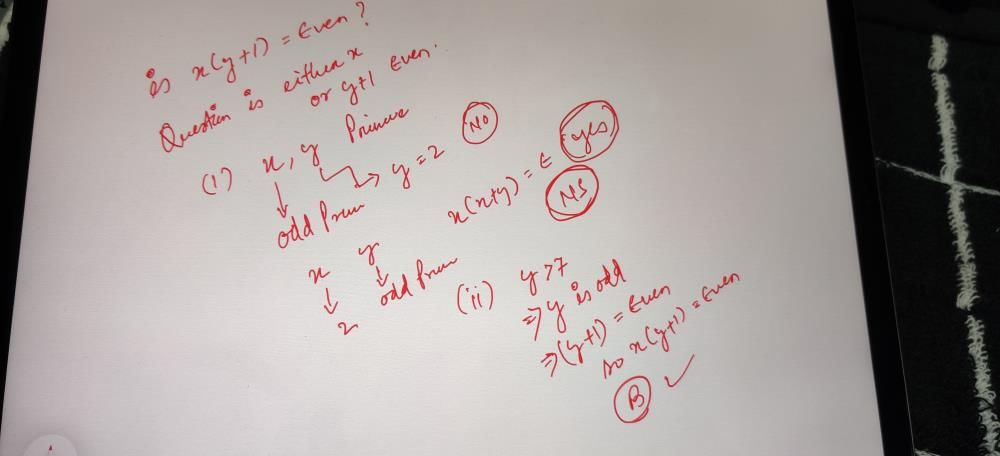GMAT Exam > GMAT Questions > If x and y are integers, is x (y + 1) an even...
Start Learning for Free
If x and y are integers, is x (y + 1) an even numb
er?
1)xand y are prime numbers.
2)y > 7 ?
a)Exactly one of the statements can answer the question
2)y > 7 ?
a)Exactly one of the statements can answer the question
b)Both statements are required to answer the question
c)Each statement can answer the question individually
d)More information is required as the information provided is insufficient to answer the question
Correct answer is option 'B'. Can you explain this answer?
Most Upvoted Answer
If x and y are integers, is x (y + 1) an even numb... moreer?1)xand y ...
1) If x and y are prime numbers, then x(y-1) can be either even or odd. For example, if x is 2 and y is 3, then x(y-1) = 2(3-1) = 4, which is even. However, if x is 3 and y is 5, then x(y-1) = 3(5-1) = 12, which is also even. Therefore, this statement alone is insufficient to determine if x(y-1) is even or odd.
2) If y is odd, then y-1 is even. In this case, x(y-1) will always be even, regardless of the value of x. For example, if y is 5, then y-1 is 4, and x(y-1) will always be even for any integer value of x. Therefore, this statement alone is sufficient to determine that x(y-1) is always even.
Combining both statements, we have conflicting information. Statement 1 tells us that x(y-1) can be either even or odd, while statement 2 tells us that x(y-1) is always even if y is odd. Therefore, the answer is not determinable.
2) If y is odd, then y-1 is even. In this case, x(y-1) will always be even, regardless of the value of x. For example, if y is 5, then y-1 is 4, and x(y-1) will always be even for any integer value of x. Therefore, this statement alone is sufficient to determine that x(y-1) is always even.
Combining both statements, we have conflicting information. Statement 1 tells us that x(y-1) can be either even or odd, while statement 2 tells us that x(y-1) is always even if y is odd. Therefore, the answer is not determinable.
Free Test
FREE
| Start Free Test |
Community Answer
If x and y are integers, is x (y + 1) an even numb... moreer?1)xand y ...


|
Explore Courses for GMAT exam
|

|
Question Description
If x and y are integers, is x (y + 1) an even numb... moreer?1)xand y are prime numbers.2)y > 7 ?a)Exactly one of the statements can answer the questionb)Both statements are required to answer the questionc)Each statement can answer the question individuallyd)More information is required as the information provided is insufficient to answer the questionCorrect answer is option 'B'. Can you explain this answer? for GMAT 2025 is part of GMAT preparation. The Question and answers have been prepared according to the GMAT exam syllabus. Information about If x and y are integers, is x (y + 1) an even numb... moreer?1)xand y are prime numbers.2)y > 7 ?a)Exactly one of the statements can answer the questionb)Both statements are required to answer the questionc)Each statement can answer the question individuallyd)More information is required as the information provided is insufficient to answer the questionCorrect answer is option 'B'. Can you explain this answer? covers all topics & solutions for GMAT 2025 Exam. Find important definitions, questions, meanings, examples, exercises and tests below for If x and y are integers, is x (y + 1) an even numb... moreer?1)xand y are prime numbers.2)y > 7 ?a)Exactly one of the statements can answer the questionb)Both statements are required to answer the questionc)Each statement can answer the question individuallyd)More information is required as the information provided is insufficient to answer the questionCorrect answer is option 'B'. Can you explain this answer?.
If x and y are integers, is x (y + 1) an even numb... moreer?1)xand y are prime numbers.2)y > 7 ?a)Exactly one of the statements can answer the questionb)Both statements are required to answer the questionc)Each statement can answer the question individuallyd)More information is required as the information provided is insufficient to answer the questionCorrect answer is option 'B'. Can you explain this answer? for GMAT 2025 is part of GMAT preparation. The Question and answers have been prepared according to the GMAT exam syllabus. Information about If x and y are integers, is x (y + 1) an even numb... moreer?1)xand y are prime numbers.2)y > 7 ?a)Exactly one of the statements can answer the questionb)Both statements are required to answer the questionc)Each statement can answer the question individuallyd)More information is required as the information provided is insufficient to answer the questionCorrect answer is option 'B'. Can you explain this answer? covers all topics & solutions for GMAT 2025 Exam. Find important definitions, questions, meanings, examples, exercises and tests below for If x and y are integers, is x (y + 1) an even numb... moreer?1)xand y are prime numbers.2)y > 7 ?a)Exactly one of the statements can answer the questionb)Both statements are required to answer the questionc)Each statement can answer the question individuallyd)More information is required as the information provided is insufficient to answer the questionCorrect answer is option 'B'. Can you explain this answer?.
Solutions for If x and y are integers, is x (y + 1) an even numb... moreer?1)xand y are prime numbers.2)y > 7 ?a)Exactly one of the statements can answer the questionb)Both statements are required to answer the questionc)Each statement can answer the question individuallyd)More information is required as the information provided is insufficient to answer the questionCorrect answer is option 'B'. Can you explain this answer? in English & in Hindi are available as part of our courses for GMAT.
Download more important topics, notes, lectures and mock test series for GMAT Exam by signing up for free.
Here you can find the meaning of If x and y are integers, is x (y + 1) an even numb... moreer?1)xand y are prime numbers.2)y > 7 ?a)Exactly one of the statements can answer the questionb)Both statements are required to answer the questionc)Each statement can answer the question individuallyd)More information is required as the information provided is insufficient to answer the questionCorrect answer is option 'B'. Can you explain this answer? defined & explained in the simplest way possible. Besides giving the explanation of
If x and y are integers, is x (y + 1) an even numb... moreer?1)xand y are prime numbers.2)y > 7 ?a)Exactly one of the statements can answer the questionb)Both statements are required to answer the questionc)Each statement can answer the question individuallyd)More information is required as the information provided is insufficient to answer the questionCorrect answer is option 'B'. Can you explain this answer?, a detailed solution for If x and y are integers, is x (y + 1) an even numb... moreer?1)xand y are prime numbers.2)y > 7 ?a)Exactly one of the statements can answer the questionb)Both statements are required to answer the questionc)Each statement can answer the question individuallyd)More information is required as the information provided is insufficient to answer the questionCorrect answer is option 'B'. Can you explain this answer? has been provided alongside types of If x and y are integers, is x (y + 1) an even numb... moreer?1)xand y are prime numbers.2)y > 7 ?a)Exactly one of the statements can answer the questionb)Both statements are required to answer the questionc)Each statement can answer the question individuallyd)More information is required as the information provided is insufficient to answer the questionCorrect answer is option 'B'. Can you explain this answer? theory, EduRev gives you an
ample number of questions to practice If x and y are integers, is x (y + 1) an even numb... moreer?1)xand y are prime numbers.2)y > 7 ?a)Exactly one of the statements can answer the questionb)Both statements are required to answer the questionc)Each statement can answer the question individuallyd)More information is required as the information provided is insufficient to answer the questionCorrect answer is option 'B'. Can you explain this answer? tests, examples and also practice GMAT tests.

|
Explore Courses for GMAT exam
|

|
Signup for Free!
Signup to see your scores go up within 7 days! Learn & Practice with 1000+ FREE Notes, Videos & Tests.


















